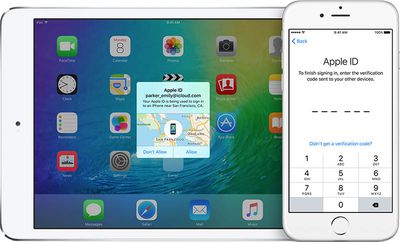With the third betas of iOS 9 and OS X 10.11 El Capitan, Apple is introducing a revamped two-factor authentication system, according to both the beta release notes and a detailed support FAQ that outlines the changes.
The new two-factor authentication system is different from Apple's existing two-step verification system, using "different methods" to trust devices and deliver verification codes. Apple also says it includes a "more streamlined user experience."
Based on the support document, the new two-factor authentication system works similarly to the existing two-step verification system. Any device that you sign into using two-factor authentication in iOS 9 or El Capitan becomes a trusted device that can be used to verify identify when signing into other devices or services linked to an Apple ID.

Apple recommends that iOS 9 and OS X El Capitan beta testers using the new two-factor authentication system update all of their devices to iOS 9 or El Capitan for "the best experience." As outlined in the release notes, customers who use two-factor authentication with older devices may be required to put a six-digit verification code at the end of a password instead of using a dedicated verification field.
If you enable two-factor authentication, iTunes purchases on Mac and Windows will require you to append a 6-digit code to the end of your password on every purchase. The 6-digit code will automatically be sent to your iOS 9 or OS X El Capitan devices.
Older devices are also not able to receive two-factor authentication codes when used with devices running iOS 9 and El Capitan, but customers who stick with the older two-step verification system should not run into any issues as Apple tests the newer two-factor authentication system. Apple does not recommend that customers using two-step verification swap over to two-factor authentication until the feature is available to all.
First introduced in March of 2013, two-factor verification is an opt-in system that increases the security of Apple ID accounts. Since its debut, Apple has been working to expand two-factor authentication to cover several different services like iCloud, iMessage, and FaceTime.
It is not entirely clear what other changes the new two-factor authentication system brings to iOS and Mac devices, but the switch to a new system may allow Apple to further extend the functionality of two-factor authentication in the future.
Update: An Apple spokesperson told Macworld that the troublesome recovery key feature that has caused people to lose their Apple ID accounts in the past has been removed in the new two-factor authentication system.
With the existing two-step verification system, either a recovery key or a trusted device/trusted phone number is required to access an Apple ID account. If both should be lost, such as when a trusted device is stolen, an Apple ID is irretrievable.
With the new authentication system, Apple's customer support team will help users recover their Apple IDs through a recovery process should both trusted devices and phone numbers become inaccessible.
If you can't sign in, reset your password, or receive verification codes, you can regain access to your account by requesting account recovery. Simply provide a verified phone number where you can receive a text message or phone call regarding your account. Apple will review your case and contact you at the number provided when your Apple ID is ready for recovery. The automated message will direct you to iforgot.apple.com to complete the required steps and regain access to your account.
Account recovery will take a few days—or longer—depending on how much information you can provide to verify that you are the account owner. The process is designed to get you back into your account as quickly as possible while denying access to anyone who might be pretending to be you.
As noted by Apple, not all beta testers and developers will have access to the new two-factor authentication system right away, but Apple plans to add additional testers gradually as we get closer to the release of iOS 9 and OS X El Capitan.























